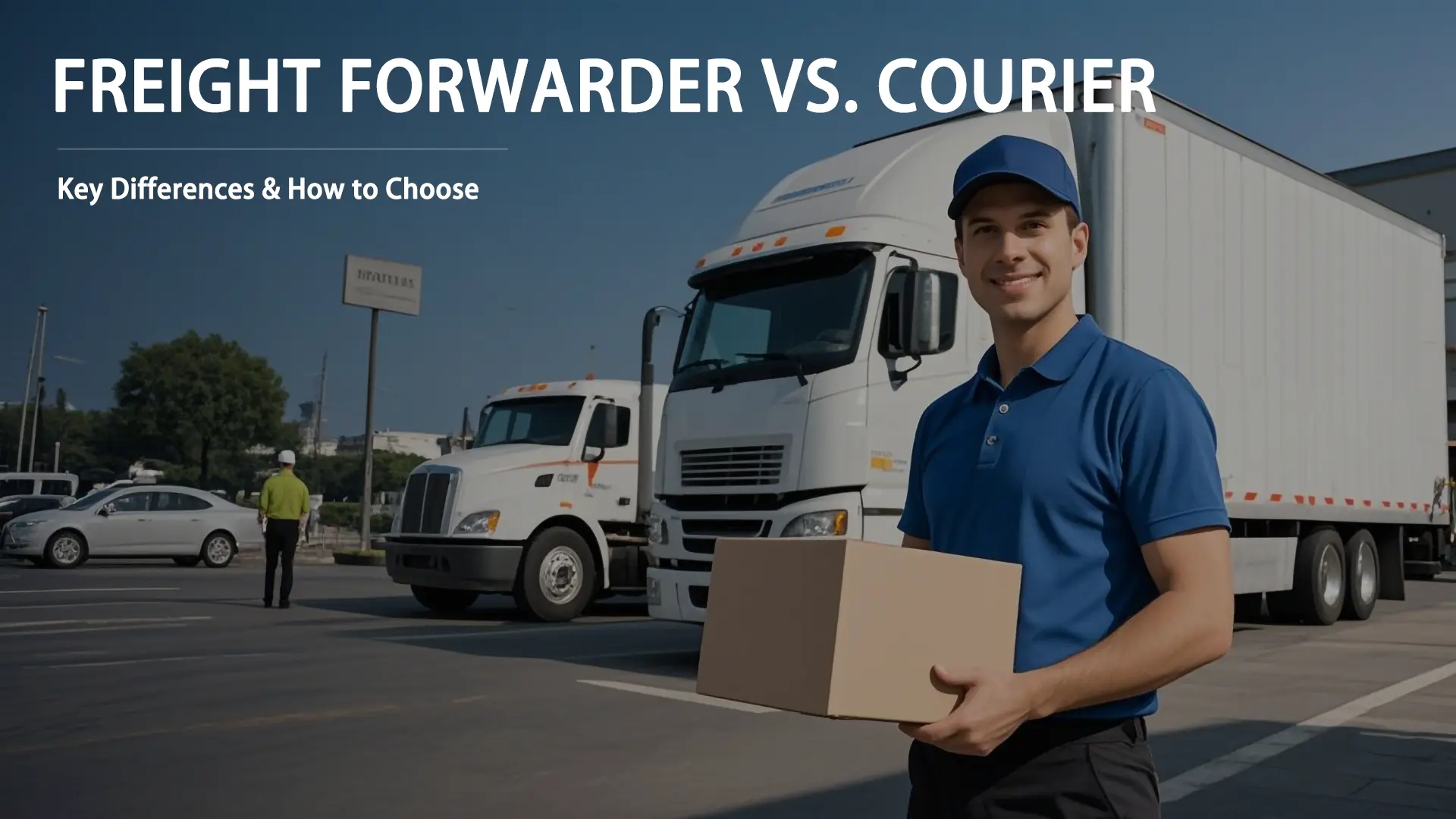Freight forwarders and international couriers are two of the main options for transporting goods for global trade and cross-border e-commerce. However, many businesses struggle to decide which solution best meets their needs. This article analyzes the core differences between freight forwarders and courier services and provides 7 actionable decision points to optimize your logistics strategy.

Part 1: 5 Core Differences Between Freight Forwarder and Courier
1. Target Clients and Cargo Types
-
Freight Forwarders:
-
Cargo Types: Bulk goods (e.g., full container loads, pallets, machinery), sensitive items (batteries, liquids, cosmetics).
-
Clients: Primarily B2B, such as manufacturers, large-scale e-commerce sellers, and import/export traders.
-
Example: A factory shipping 10 tons of machinery to Germany via sea freight with export tax rebate handling.
-
-
Courier Companies:
-
Cargo Types: Small parcels (≤100kg/pcs), documents, and samples (general goods).
-
Clients: Both B2B and B2C, including individuals and SMEs.
-
Example: Sending a contract to the U.S. with next-day door-to-door delivery.
-
2. Transport Modes and Network Coverage
-
Freight Forwarders:
-
Multimodal transport (sea, air, rail, truck) with flexible routing.
-
Partner-dependent networks, often specializing in specific trade lanes (e.g., China-U.S. routes).
-
Value-Added Services: Customs clearance, warehousing, insurance, tax refunds.
-
-
Courier Companies:
-
Dedicated air fleets + ground networks (e.g., DHL operates 260+ aircraft).
-
Global reach (e.g., UPS serves 220+ countries), including remote areas.
-
Value-Added Services: Real-time tracking, declared value coverage, cash-on-delivery.
-
3. Cost vs. Speed Comparison
| Factor | Freight Forwarders | Courier Companies |
|---|---|---|
| Speed | 30-40 days (sea), 5-7 days (air) | 3-5 days (international) |
| Cost | $1,500/40HQ container (China to L.A.) | $50-80 for 1kg document to U.S. |
| Cost Efficiency | Ideal for bulk, non-urgent shipments | Best for small, time-sensitive items |
(Data Sources: Industry Reports 2024)
key notes: The data is for reference only!
4. Liability and Risk Management
-
Freight Forwarders:
-
Risk distributed among carriers (shipping lines, airlines). Claims resolved per transport leg (e.g., Hague-Visby Rules for sea freight).
-
-
Courier Companies:
-
End-to-end responsibility. Standard compensation: uninsured items reimbursed at 3x freight cost; insured items covered at declared value.
-
5. Operational Complexity
-
Freight Forwarder Process: Booking → Cargo pickup → Customs clearance → Main transport → Destination clearance → Last-mile delivery (7-15 steps).
-
Courier Process: Order → Pickup → Sorting → International transit → Customs → Delivery (4-6 steps).
Part 2: How to Choose? 7 Key Decision Points
1. Cargo Specifications
-
Weight/Volume:
-
>300kg: Freight forwarders (cost-effective for LCL/FCL).
-
<30kg: Couriers (e.g., DHL/UPS for speed).
-
-
Sensitivity:
-
Batteries, liquids, or food items require freight forwarders with specialized channels.
-
2. Delivery Urgency
-
Urgent Documents/Samples: Couriers (e.g., DHL’s 48-hour delivery to Europe/U.S.).
-
Non-Urgent Bulk Cargo: Freight forwarders (sea/air).
3. Budget Constraints
-
Low-Cost Priority: Freight forwarders offer rates 50-70% lower than retail (e.g., sea LCL at $3/kg).
-
Speed Over Cost: Couriers (e.g., FedEx U.S. Express at $25/kg).
4. Customs Complexity
-
High Complexity (e.g., chemical certifications, duty disputes): Freight forwarders with DDP (Delivered Duty Paid) services.
-
Simple Clearance: Couriers handle basic customs procedures.
5. Delivery Scope
-
Remote Areas: Couriers (e.g., DHL’s reach to rural Africa).
-
Port Pickup: Freight forwarders require local last-mile partners.
6. Value-Added Needs
-
Warehousing/Packaging: Freight forwarders often include free storage (e.g., 30-day free warehousing).
-
Returns Management: Combine freight forwarders with overseas warehouses.
7. Long-Term Partnerships
-
High-Volume Shippers: Negotiate volume discounts with freight forwarders.
-
Occasional Needs: Couriers for pay-as-you-go flexibility.
Part 3: Hybrid Solutions for Special Scenarios
Case 1: Cross-Border E-Commerce Seller
-
First Mile: Freight forwarder ships goods from China to U.S. warehouse (sea FCL at $1,200/container).
-
Last Mile: Local courier (e.g., UPS) delivers in 3 days at $5/kg.
Case 2: Sensitive Goods Export
-
Channel: Freight forwarder’s specialized line (e.g., battery-friendly air freight) with DDP to avoid customs seizures.
Part 4: Decision-Making Flowchart
-
Step 1: Define cargo type, weight, and urgency.
-
Step 2: Evaluate budget and customs requirements.
-
Step 3: Choose freight forwarder (bulk/sensitive) or courier (small/urgent).
-
Step 4: Opt for a hybrid model (freight + courier) to balance cost and speed.
Take Action Now:
-
Get a customized quote: Freight Forwarder Platform
Learn More: How to Find the Best Freight Forwarder in China
Comments on “Freight Forwarder vs Courier: Key Differences and How to Choose”